Data Structure and Algorithm - Day 12
-
Advanced Search
-
Pruning
-
Bidirectional Breadth First Search
-
Heuristic search (A* Search)
public class AStar { public final static int BAR = 1; // 障碍值 public final static int PATH = 2; // 路径 public final static int DIRECT_VALUE = 10; // 横竖移动代价 public final static int OBLIQUE_VALUE = 14; // 斜移动代价 Queue<Node> openList = new PriorityQueue<Node>(); // 优先队列(升序) List<Node> closeList = new ArrayList<Node>(); /** * 开始算法 */ public void start(MapInfo mapInfo) { if(mapInfo==null) return; // clean openList.clear(); closeList.clear(); // 开始搜索 openList.add(mapInfo.start); moveNodes(mapInfo); } /** * 移动当前结点 */ private void moveNodes(MapInfo mapInfo) { while (!openList.isEmpty()) { Node current = openList.poll(); closeList.add(current); addNeighborNodeInOpen(mapInfo,current); if (isCoordInClose(mapInfo.end.coord)) { drawPath(mapInfo.maps, mapInfo.end); break; } } } /** * 在二维数组中绘制路径 */ private void drawPath(int[][] maps, Node end) { if(end==null||maps==null) return; System.out.println("总代价:" + end.G); while (end != null) { Coord c = end.coord; maps[c.y][c.x] = PATH; end = end.parent; } } /** * 添加所有邻结点到open表 */ private void addNeighborNodeInOpen(MapInfo mapInfo,Node current) { int x = current.coord.x; int y = current.coord.y; // 左 addNeighborNodeInOpen(mapInfo,current, x - 1, y, DIRECT_VALUE); // 上 addNeighborNodeInOpen(mapInfo,current, x, y - 1, DIRECT_VALUE); // 右 addNeighborNodeInOpen(mapInfo,current, x + 1, y, DIRECT_VALUE); // 下 addNeighborNodeInOpen(mapInfo,current, x, y + 1, DIRECT_VALUE); // 左上 addNeighborNodeInOpen(mapInfo,current, x - 1, y - 1, OBLIQUE_VALUE); // 右上 addNeighborNodeInOpen(mapInfo,current, x + 1, y - 1, OBLIQUE_VALUE); // 右下 addNeighborNodeInOpen(mapInfo,current, x + 1, y + 1, OBLIQUE_VALUE); // 左下 addNeighborNodeInOpen(mapInfo,current, x - 1, y + 1, OBLIQUE_VALUE); } /** * 添加一个邻结点到open表 */ private void addNeighborNodeInOpen(MapInfo mapInfo,Node current, int x, int y, int value) { if (canAddNodeToOpen(mapInfo,x, y)) { Node end=mapInfo.end; Coord coord = new Coord(x, y); int G = current.G + value; // 计算邻结点的G值 Node child = findNodeInOpen(coord); if (child == null) { int H=calcH(end.coord,coord); // 计算H值 if(isEndNode(end.coord,coord)) { child=end; child.parent=current; child.G=G; child.H=H; } else { child = new Node(coord, current, G, H); } openList.add(child); } else if (child.G > G) { child.G = G; child.parent = current; openList.add(child); } } } /** * 从Open列表中查找结点 */ private Node findNodeInOpen(Coord coord) { if (coord == null || openList.isEmpty()) return null; for (Node node : openList) { if (node.coord.equals(coord)) { return node; } } return null; } /** * 计算H的估值:“曼哈顿”法,坐标分别取差值相加 */ private int calcH(Coord end,Coord coord) { return Math.abs(end.x - coord.x) + Math.abs(end.y - coord.y); } /** * 判断结点是否是最终结点 */ private boolean isEndNode(Coord end,Coord coord) { return coord != null && end.equals(coord); } /** * 判断结点能否放入Open列表 */ private boolean canAddNodeToOpen(MapInfo mapInfo,int x, int y) { // 是否在地图中 if (x < 0 || x >= mapInfo.width || y < 0 || y >= mapInfo.hight) return false; // 判断是否是不可通过的结点 if (mapInfo.maps[y][x] == BAR) return false; // 判断结点是否存在close表 if (isCoordInClose(x, y)) return false; return true; } /** * 判断坐标是否在close表中 */ private boolean isCoordInClose(Coord coord) { return coord!=null&&isCoordInClose(coord.x, coord.y); } /** * 判断坐标是否在close表中 */ private boolean isCoordInClose(int x, int y) { if (closeList.isEmpty()) return false; for (Node node : closeList) { if (node.coord.x == x && node.coord.y == y) { return true; } } return false; } }
-
-
36. Valid Sudoku
Determine if a
9 x 9Sudoku board is valid. Only the filled cells need to be validated according to the following rules:- Each row must contain the digits
1-9without repetition. - Each column must contain the digits
1-9without repetition. - Each of the nine
3 x 3sub-boxes of the grid must contain the digits1-9without repetition.
Note:
- A Sudoku board (partially filled) could be valid but is not necessarily solvable.
- Only the filled cells need to be validated according to the mentioned rules.
Input: board = [["5","3",".",".","7",".",".",".","."] ,["6",".",".","1","9","5",".",".","."] ,[".","9","8",".",".",".",".","6","."] ,["8",".",".",".","6",".",".",".","3"] ,["4",".",".","8",".","3",".",".","1"] ,["7",".",".",".","2",".",".",".","6"] ,[".","6",".",".",".",".","2","8","."] ,[".",".",".","4","1","9",".",".","5"] ,[".",".",".",".","8",".",".","7","9"]] Output: trueExample 2:
Input: board = [["8","3",".",".","7",".",".",".","."] ,["6",".",".","1","9","5",".",".","."] ,[".","9","8",".",".",".",".","6","."] ,["8",".",".",".","6",".",".",".","3"] ,["4",".",".","8",".","3",".",".","1"] ,["7",".",".",".","2",".",".",".","6"] ,[".","6",".",".",".",".","2","8","."] ,[".",".",".","4","1","9",".",".","5"] ,[".",".",".",".","8",".",".","7","9"]] Output: false Explanation: Same as Example 1, except with the 5 in the top left corner being modified to 8. Since there are two 8's in the top left 3x3 sub-box, it is invalid.Constraints:
board.length == 9board[i].length == 9board[i][j]is a digit or'.'.
class Solution { public boolean isValidSudoku(char[][] board) { boolean[][] rows = new boolean[9][9]; boolean[][] cols = new boolean[9][9]; boolean[][] blocks = new boolean[9][9]; for (int i = 0; i < 9; i++) { for (int j = 0; j < 9; j++) { if (board[i][j] == '.') continue; if (rows[i][board[i][j] - '1']) return false; if (cols[j][board[i][j] - '1']) return false; int block = i/3 * 3 + j/3; if (blocks[block][board[i][j] - '1']) return false; rows[i][board[i][j] - '1'] = true; cols[j][board[i][j] - '1'] = true; blocks[block][board[i][j] - '1'] = true; } } return true; } } - Each row must contain the digits
-
37. Sudoku Solver
Write a program to solve a Sudoku puzzle by filling the empty cells.
A sudoku solution must satisfy all of the following rules:
- Each of the digits
1-9must occur exactly once in each row. - Each of the digits
1-9must occur exactly once in each column. - Each of the digits
1-9must occur exactly once in each of the 93x3sub-boxes of the grid.
The
'.'character indicates empty cells.Input: board = [["5","3",".",".","7",".",".",".","."],["6",".",".","1","9","5",".",".","."],[".","9","8",".",".",".",".","6","."],["8",".",".",".","6",".",".",".","3"],["4",".",".","8",".","3",".",".","1"],["7",".",".",".","2",".",".",".","6"],[".","6",".",".",".",".","2","8","."],[".",".",".","4","1","9",".",".","5"],[".",".",".",".","8",".",".","7","9"]] Output: [["5","3","4","6","7","8","9","1","2"],["6","7","2","1","9","5","3","4","8"],["1","9","8","3","4","2","5","6","7"],["8","5","9","7","6","1","4","2","3"],["4","2","6","8","5","3","7","9","1"],["7","1","3","9","2","4","8","5","6"],["9","6","1","5","3","7","2","8","4"],["2","8","7","4","1","9","6","3","5"],["3","4","5","2","8","6","1","7","9"]] Explanation: The input board is shown above and the only valid solution is shown below:Constraints:
board.length == 9board[i].length == 9board[i][j]is a digit or'.'.- It is guaranteed that the input board has only one solution.
class Solution { boolean[][] rows = new boolean[9][9]; boolean[][] cols = new boolean[9][9]; boolean[][] blocks = new boolean[9][9]; char[] nums = {'1','2','3','4','5','6','7','8','9'}; char[][] board; public void solveSudoku(char[][] board) { this.board = board; for (int i = 0; i < 9; i++) { for (int j = 0; j < 9; j++) { if (board[i][j] == '.') continue; rows[i][board[i][j] - '1'] = true; cols[j][board[i][j] - '1'] = true; blocks[i/3 * 3 + j/3][board[i][j] - '1'] = true; } } dfs(0, 0); } private boolean dfs(int i, int j) { if (j == 9){ i++; j = 0; if (i == 9) return true; } if (board[i][j] != '.') { return dfs(i, j + 1); } for (char num : nums) { if (rows[i][num - '1'] || cols[j][num - '1'] || blocks[i/3 * 3 + j/3][num - '1']) { continue; } board[i][j] = num; rows[i][num - '1'] = true; cols[j][num - '1'] = true; blocks[i/3 * 3 + j/3][num - '1'] = true; if (dfs(i, j + 1)) return true; rows[i][num - '1'] = false; cols[j][num - '1'] = false; blocks[i/3 * 3 + j/3][num - '1'] = false; board[i][j] = '.'; } return false; } } - Each of the digits
-
1091. Shortest Path in Binary Matrix
Given an
n x nbinary matrixgrid, return the length of the shortest clear path in the matrix. If there is no clear path, return-1.A clear path in a binary matrix is a path from the top-left cell (i.e.,
(0, 0)) to the bottom-right cell (i.e.,(n - 1, n - 1)) such that:- All the visited cells of the path are
0. - All the adjacent cells of the path are 8-directionally connected (i.e., they are different and they share an edge or a corner).
The length of a clear path is the number of visited cells of this path.
Example 1:

Input: grid = [[0,1],[1,0]] Output: 2Example 2:
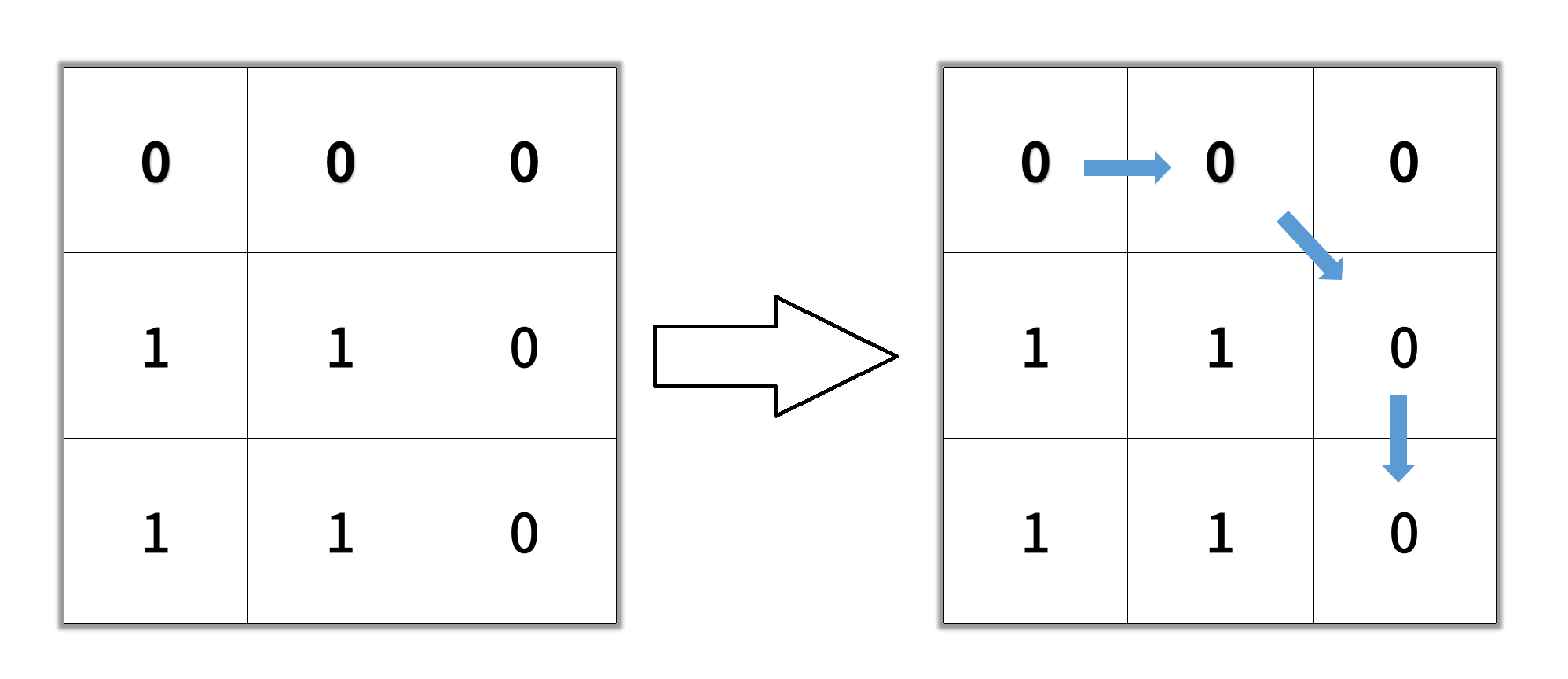
Input: grid = [[0,0,0],[1,1,0],[1,1,0]] Output: 4Example 3:
Input: grid = [[1,0,0],[1,1,0],[1,1,0]] Output: -1Constraints:
n == grid.lengthn == grid[i].length1 <= n <= 100grid[i][j] is 0 or 1
class Solution { int[][] dirs = {{0,1},{0,-1},{1,0},{-1,0},{1,1},{1,-1},{-1,1},{-1,-1}}; public int shortestPathBinaryMatrix(int[][] grid) { if (grid[0][0] == 1) return -1; Deque<int[]> deque = new LinkedList<>(); int m = grid.length, n = grid[0].length; deque.addLast(new int[]{0,0}); grid[0][0] = 1; int res = 0; while (!deque.isEmpty()) { int size = deque.size(); res++; while (size-- > 0) { int[] pos = deque.pollFirst(); int x = pos[0], y = pos[1]; if (x == m - 1 && y == n - 1) { return res; } for (int[] dir : dirs) { int i = x + dir[0], j = y + dir[1]; if (i >= 0 && i < grid.length && j >= 0 && j < grid[0].length && grid[i][j] == 0) { deque.addLast(new int[]{i, j}); grid[i][j] = 1; } } } } return -1; } } - All the visited cells of the path are
-
AVL Tree
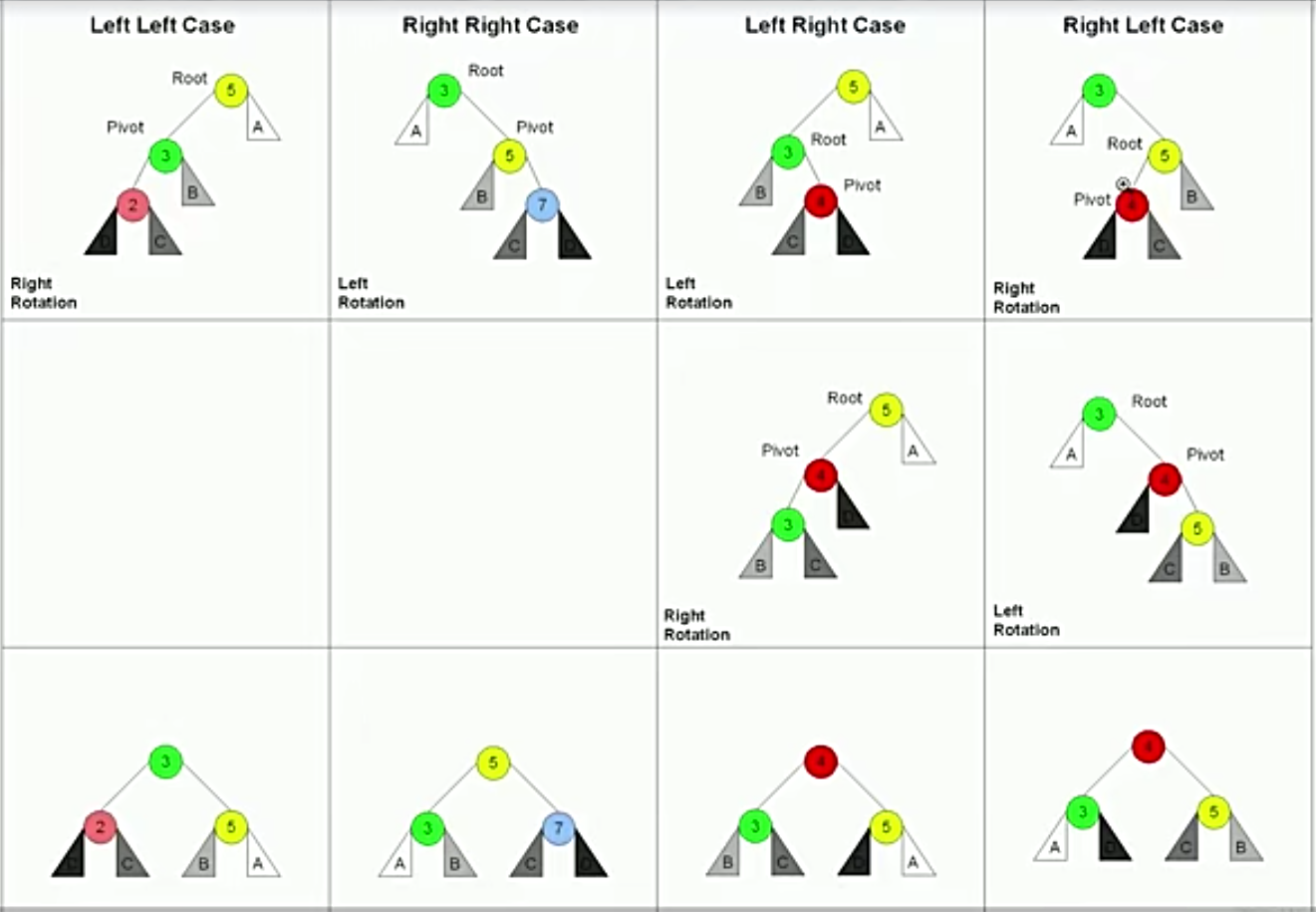
-
Red Black Tree
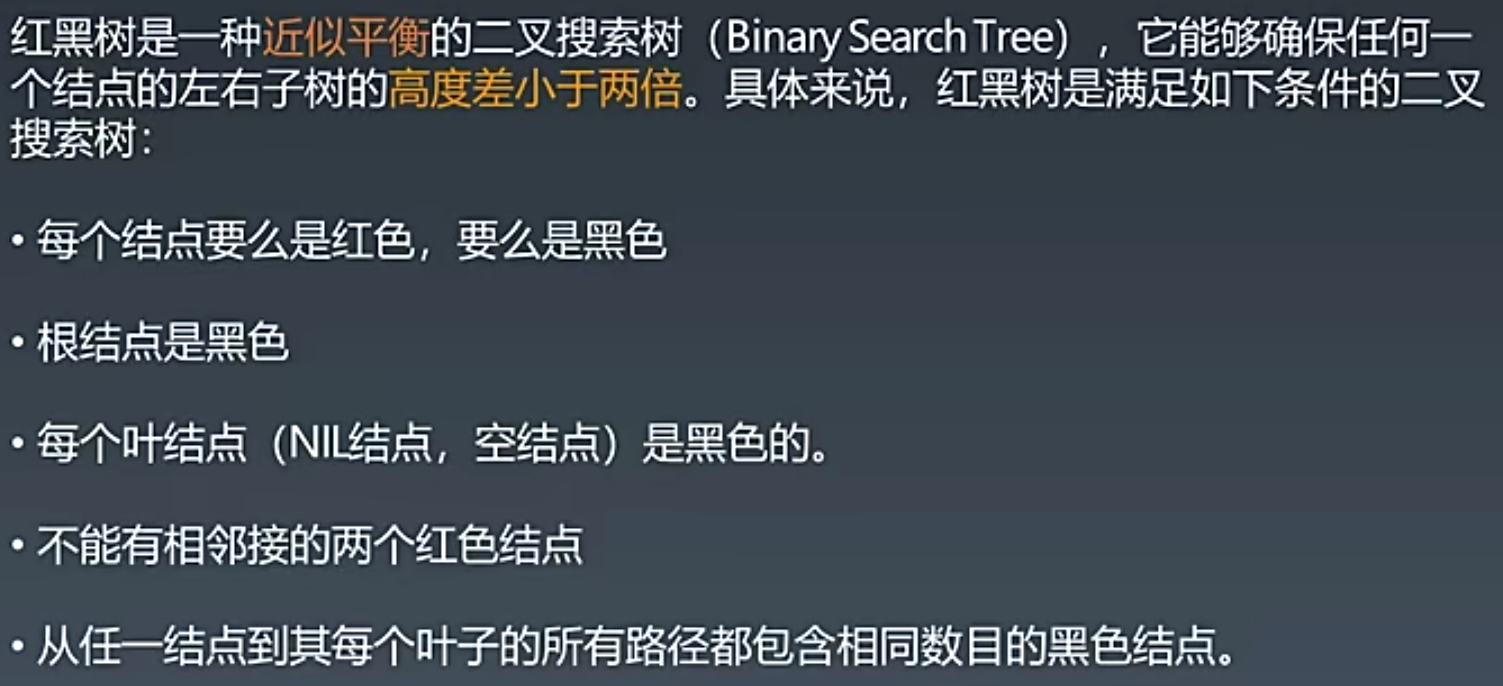
vs AVL Tree
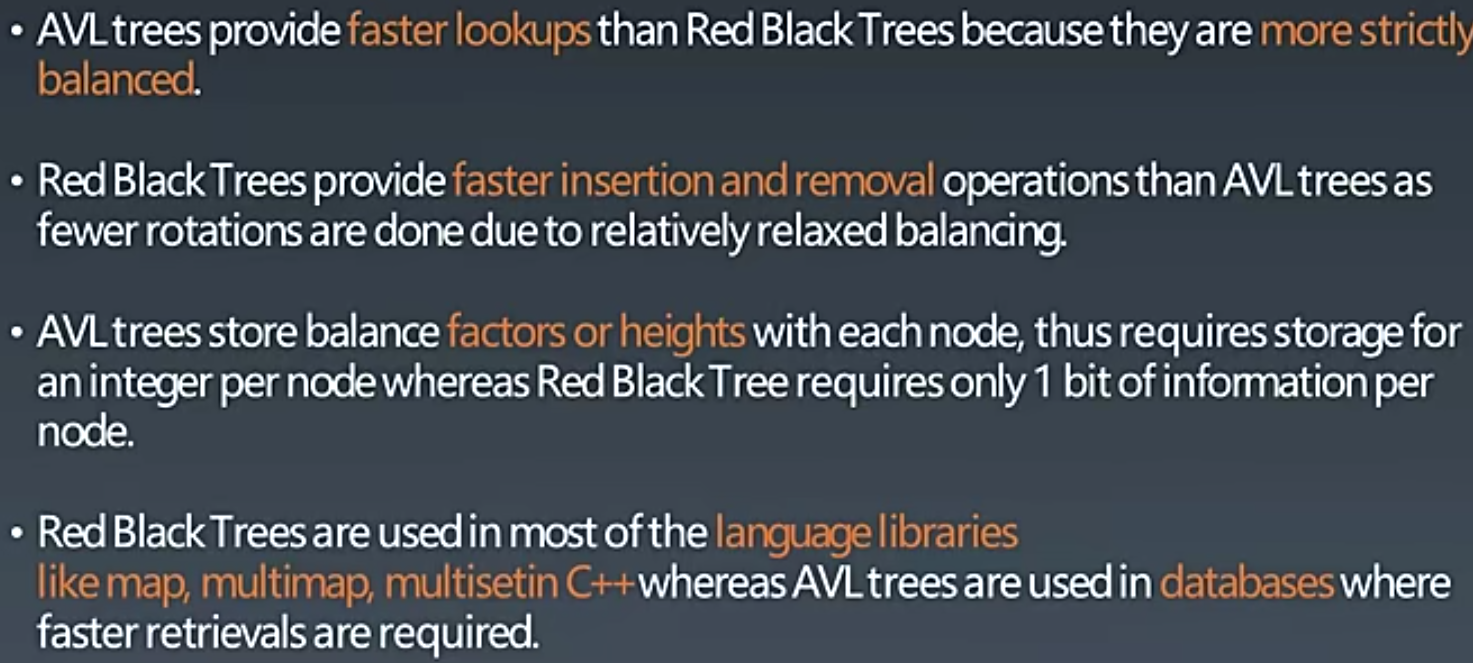
-
Bit Operation
<<: 0011=>0110 >>: 0110=>0011 | : 0011|1011=>1011 & : 0011&1011=>0011 ~ : 0011=>1100 ^ : 0011^1011=>1000 x ^ 0 = x x ^ (~x) = (~0) = 1s(all one) x ^ 1s = ~x x ^ x = 0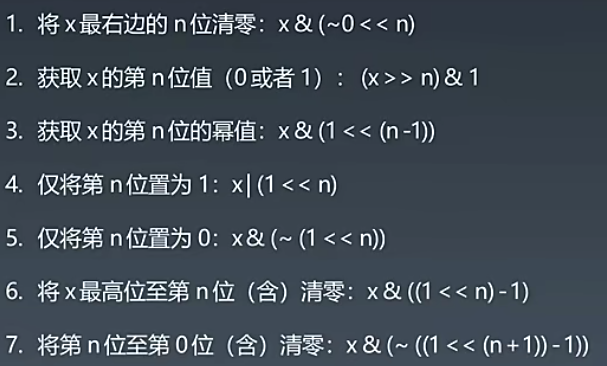
apply
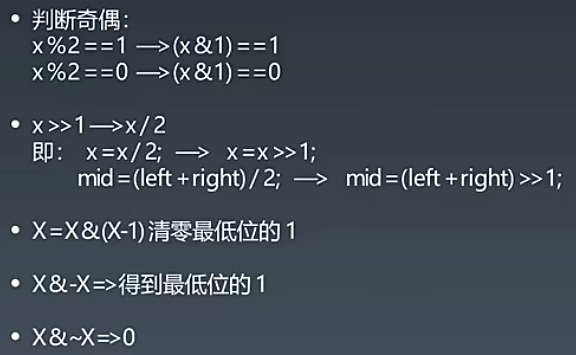
-
191. Number of 1 Bits
Write a function that takes an unsigned integer and returns the number of '1' bits it has (also known as the Hamming weight).
Note:
- Note that in some languages, such as Java, there is no unsigned integer type. In this case, the input will be given as a signed integer type. It should not affect your implementation, as the integer's internal binary representation is the same, whether it is signed or unsigned.
- In Java, the compiler represents the signed integers using 2's complement notation. Therefore, in Example 3, the input represents the signed integer.
-3.
Example 1:
Input: n = 00000000000000000000000000001011 Output: 3 Explanation: The input binary string 00000000000000000000000000001011 has a total of three '1' bits.Example 2:
Input: n = 00000000000000000000000010000000 Output: 1 Explanation: The input binary string 00000000000000000000000010000000 has a total of one '1' bit.Example 3:
Input: n = 11111111111111111111111111111101 Output: 31 Explanation: The input binary string 11111111111111111111111111111101 has a total of thirty one '1' bits.Constraints:
- The input must be a binary string of length
32.
public class Solution { public int hammingWeight(int n) { int res = 0; while (n != 0) { res += (n&1) == 1 ? 1 : 0; n = n >>> 1; } return res; } } -
231. Power of Two
Given an integer
n, returntrueif it is a power of two. Otherwise, returnfalse.An integer
nis a power of two, if there exists an integerxsuch thatn == 2x.Example 1:
Input: n = 1 Output: true Explanation: 20 = 1Example 2:
Input: n = 16 Output: true Explanation: 24 = 16Example 3:
Input: n = 3 Output: falseExample 4:
Input: n = 4 Output: trueExample 5:
Input: n = 5 Output: falseConstraints:
-231 <= n <= 231 - 1
class Solution { public boolean isPowerOfTwo(int n) { return n > 0 && (n & (n - 1)) == 0; } } -
190. Reverse Bits
Reverse bits of a given 32 bits unsigned integer.
Note:
- Note that in some languages such as Java, there is no unsigned integer type. In this case, both input and output will be given as a signed integer type. They should not affect your implementation, as the integer's internal binary representation is the same, whether it is signed or unsigned.
- In Java, the compiler represents the signed integers using 2's complement notation. Therefore, in Example 2 above, the input represents the signed integer
-3and the output represents the signed integer-1073741825.
Follow up:
If this function is called many times, how would you optimize it?
Example 1:
Input: n = 00000010100101000001111010011100 Output: 964176192 (00111001011110000010100101000000) Explanation: The input binary string 00000010100101000001111010011100 represents the unsigned integer 43261596, so return 964176192 which its binary representation is 00111001011110000010100101000000.Example 2:
Input: n = 11111111111111111111111111111101 Output: 3221225471 (10111111111111111111111111111111) Explanation: The input binary string 11111111111111111111111111111101 represents the unsigned integer 4294967293, so return 3221225471 which its binary representation is 10111111111111111111111111111111.Constraints:
- The input must be a binary string of length
32
public class Solution { // you need treat n as an unsigned value public int reverseBits(int n) { int res = 0; for (int i = 0; i < 32; i++) { res <<= 1; res += n & 1; n >>>= 1; } return res; } } -
338. Counting Bits
Given an integer
num, return an array of the number of1's in the binary representation of every number in the range[0, num].Example 1:
Input: num = 2 Output: [0,1,1] Explanation: 0 --> 0 1 --> 1 2 --> 10Example 2:
Input: num = 5 Output: [0,1,1,2,1,2] Explanation: 0 --> 0 1 --> 1 2 --> 10 3 --> 11 4 --> 100 5 --> 101Constraints:
0 <= num <= 105
// stupid count class Solution { public int[] countBits(int num) { int[] res = new int[num + 1]; for (int i = 1; i <= num; i++) { res[i] = countBit(i); } return res; } private int countBit(int num) { if (num == 0) return 0; return 1 + countBit(num & (num - 1)); } } // DP class Solution { public int[] countBits(int num) { int[] bits = new int[num + 1]; for (int i = 1; i <= num; i++) { bits[i] = bits[i >> 1] + (i & 1); } return bits; } }





【推荐】还在用 ECharts 开发大屏?试试这款永久免费的开源 BI 工具!
【推荐】国内首个AI IDE,深度理解中文开发场景,立即下载体验Trae
【推荐】编程新体验,更懂你的AI,立即体验豆包MarsCode编程助手
【推荐】轻量又高性能的 SSH 工具 IShell:AI 加持,快人一步
· 继承的思维:从思维模式到架构设计的深度解析
· 如何在 .NET 中 使用 ANTLR4
· 后端思维之高并发处理方案
· 理解Rust引用及其生命周期标识(下)
· 从二进制到误差:逐行拆解C语言浮点运算中的4008175468544之谜
· 35岁程序员的中年求职记:四次碰壁后的深度反思
· 当职场成战场:降职、阴谋与一场硬碰硬的抗争
· 用99元买的服务器搭一套CI/CD系统
· Excel百万数据如何快速导入?
· ShadowSql之.net sql拼写神器